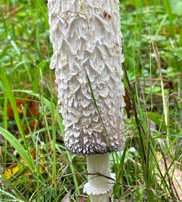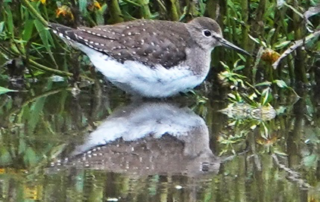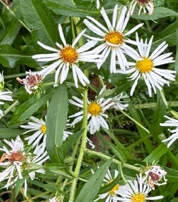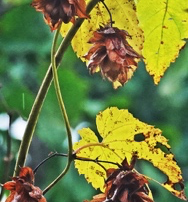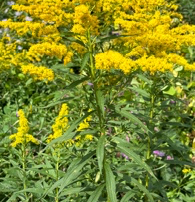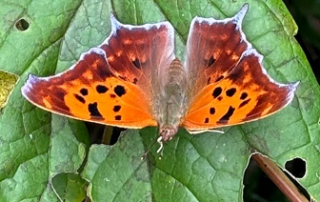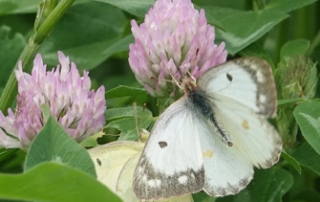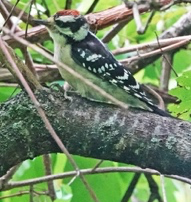About corrine
This author has not yet filled in any details.So far corrine has created 49 blog entries.
Ernest Williams Nature Observations – May 1 2025

This is an exciting time of year as we watch spring rapidly unfold. All the photos here are from this week, with the highlighted species appearing right on schedule. White trillium and marsh marigold have burst forth in the past 3 days, particularly between the pond (distance marker #10) and the glade (#14). See the photo to the right. Violets, foamflower, and wild ginger are newly open, and shadbush, a small tree (so named because it flowers when the shade are running), is in flower (it’s also known as serviceberry).
With birds, new spring migrants are appearing daily; the last two days on the trail have brought yellow warbler, common yellowthroat, chestnut-sided warbler, great crested flycatcher, and Baltimore oriole, while ruby-crowned kinglet and house wren appeared a few days earlier. The pond always has surprises (three shown here). Bluebirds investigated the bluebird boxes just north of Dugway Rd, but tree swallows have take n over nesting in all four. You can watch swallows fly in and out of the boxes.
Don’t overlook other kinds of wildlife, too, such as emerald green tiger beetles and cabbage white butterflies along the trail and painted turtles sunning at the pond margins. Keep your eyes open; every week is different.

2025 Appeal Letter from KT President Chip Bassett

Dear Friends and Neighbors:
Please help us as the Board and other Kirkland Trails volunteers work to develop a network of trails in the Town of Kirkland. Since our founding in 2018, and thanks to the generosity of our community, we have made steady progress in developing the Kirkland South Section of the Chenango Canal Trail. With the upgrade last summer of the trail north of Dugway Road to NYS Route 12B, the Town of Kirkland now has a three-mile trail to Deansboro where it connects to the three-mile Town of Marshall trail ending in Oriskany Falls. We now need your help to
accomplish the next phases of our plan.
In 2024, the Town of Kirkland was awarded a $1.5 million federal TAP Grant to help develop portions of the planned two-mile Kirkland North Section Trail. Kirkland Trails helped write the grant application. The grant covers 80% of the total project cost ($1.9 million), while the remaining 20% ($400,000 – the local share) has been split equally by the Town and Kirkland Trails. Work on the north section is expected to begin this year and be finished by the end of 2026 or in 2027. The remaining portions not funded through the TAP Grant will be constructed by the Town Highway Department with materials purchased by Kirkland Trails. We need to raise the funds for the trail materials.
In addition, last year we learned that the NYS Department of Transportation plans to replace the NYS Route 12B bridge over Oriskany Creek near the Kirkland South Section trailhead in the next two to three years. Kirkland Trails representatives met with the DOT engineers to discuss the possibility of adding a pedestrian/bicycle lane to the new bridge. The Department of Transportation has generously planned to include the bridge lane and to construct trails segments connecting the bridge to our current trailhead to the west and to Furnace Street to the east. Kirkland Trails has been asked to raise funds for these trail segments and for a possible trailhead parking area.
We are very excited about these plans for new trail construction during the next two years, and we want to keep up our current momentum. To do so, we need to replenish our trail development funds. We will seek grants, but they generally require a local share of 20% to 25%. We also will work with our Town, County and State governments to identify other sources of funding. They each have already been crucial to our success. It benefits the organization when we can point to strong community support for trails. Your contribution to and membership in Kirkland Trails demonstrates this support. To become a member, all you need to do is contribute whatever amount you wish. Help keep our momentum going to complete the multi-use trail through the Town of Kirkland from Deansboro north to Clark Mills and beyond. If you are currently a member, thank you for your past donation. We hope you will continue to contribute and maintain your membership. If you are not a member now, please consider joining our effort to build trails in our community. As a member you are welcome to attend our board meetings and will receive our annual newsletter, regular Nature Updates from our resident naturalist, notices of important meetings and an invitation to our Annual Membership meeting. This year and 2026 are big years for us. We will need considerable support from our community to make all this new trail construction a reality.
Happy trails. Thanks for your support.
Sincerely,
Chip Bassett
Ernest Williams Nature Observations – October 1, 2024
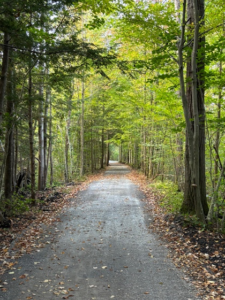 The one-mile trail north of Dugway Rd is now ready! We will celebrate the completion of this part of the trail at 3:00 pm, Tuesday, Oct. 1. Take a walk and see what you can find. Some habitats here differ from those found along the trail south of Dugway, which means some different nature sightings.
The one-mile trail north of Dugway Rd is now ready! We will celebrate the completion of this part of the trail at 3:00 pm, Tuesday, Oct. 1. Take a walk and see what you can find. Some habitats here differ from those found along the trail south of Dugway, which means some different nature sightings.
Late season always brings out a wonderful diversity of asters and goldenrods, as shown below, and there are more species in each group than are shown below (8 asters, 4 goldenrods). We still find occasional flowers that we’ve been seeing since earlier in the summer such as soapwort, evening primrose, and pale and spotted jewelweed, though they are now fewer in number. The subtle and camouflaged appearance of beech drops belies their presence, but you’ll find them near beech trees because, rather than being photosynthetic, they are parasitic on beech roots. Mushrooms and other fungi are emerging, too; see the shaggy mane shown here. This is also a season of seeds and fruits, of course, some of which are colorful to attract
birds to disperse the plant’s seeds. Finding wild hops along the trail is a reminder of this region’s importance long ago in hops production.
The edges of the pond often conceal surprises, so look beyond any ducks and geese that may be on the water, and you may find a (very attractive) solitary sandpiper as I did 2 days ago. This nature update is the last of 2024, but keep looking along the trail. What new sightings will we find next year?
Ernest Williams Nature Observations – September 1, 2024
More than 50 plant species are in flower and fruit along the trail now, and below is just a selection of what you can find. This is the time of greatest diversity of flowering species and of floral shape (different kinds of pollinators are attracted to different floral characteristics). One of the flowering plants is spotted knapweed, which may look pretty but is a nasty invasive that crowds out native plants; feel free to kill it. Birds on the trail currently include mostly common species (chickadee, robin, catbird, crow, Carolina wren, goldfinch, woodpeckers), but we’re seeing many of the young produced this year. A wood duck family has stayed regularly at the pond. Sulphur butterflies are now numerous in the fields by Dugway Rd, and in the photo below, a male sulphur underneath is trying to mate with the female above (some females are white rather than yellow). Beautiful, freshly emerged question mark butterflies are out, showing why in the 1800s they were called violet-tips. Of course this is a season of fruit production, with red, black, and white berries, as well as other fruiting structures, providing food to birds and other animals in exchange for seed dispersal.












